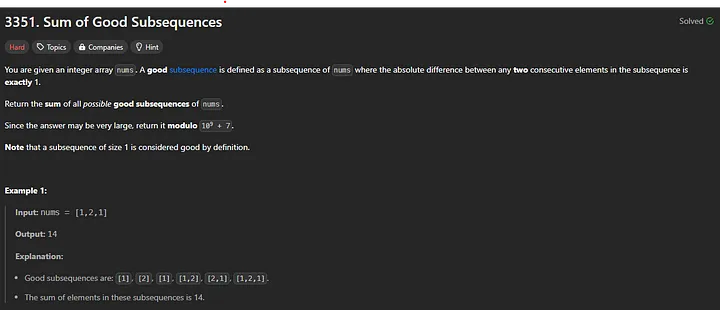3351. Sum of Good Subsequences
Sum of Good Subsequences
Approach to the Problem
We are tasked with finding the sum of all possible good subsequences in a given array nums where a good subsequence satisfies the condition that the absolute difference between any two consecutive elements is exactly 1. Here’s how we can systematically solve this problem.
Understand the Problem
- Subsequences: A subsequence is a sequence derived from an array by deleting some or no elements without changing the order of the remaining elements. Example: [1, 2, 1] has subsequences: [1], [2], [1], [1, 2], [2, 1], [1, 2, 1].
- Good Subsequences: A subsequence is good if the absolute difference between consecutive elements is exactly 1.
- Goal: Compute the sum of all good subsequences modulo 10⁹+7. Brute-Force Approach
- Generating All the Subsequences: Use recursion or bitmasking to generate all possible subsequences of the array. Check if each subsequence is good by ensuring the condition ∣a[i]−a[i−1]∣ = 1 is satisfied for all consecutive elements. Sum up all elements of the good subsequences.
- Time Complexity: Generating all subsequences takes O(2^n), where n is the length of the array. Verifying each subsequence for the good property takes O(n) in the worst case. Overall: O(n⋅2^n). This is infeasible for large n (up to 10⁵). Optimal Approach To handle the constraints efficiently, we use a dynamic programming approach with optimization based on frequencies of numbers in the array.
Algorithm We Use:-
- Frequency Array: Count the occurrences of each number in the array. This allows us to consider only the numbers present in the array, reducing unnecessary computation.
- Dynamic Programming Arrays: Using two arrays:
sum[c]: Tracks the sum of elements in all good subsequences ending with number c. count[c]: Tracks the number of good subsequences ending with number c. Transition: For each number c in nums:
Add contributions from subsequences ending at c-1 (if c-1 exists in the array). Add contributions from subsequences ending at c+1 (if c+1 exists in the array). Add the number c itself as a single-element subsequence. Modulo: Since the answer can be large, perform all computations modulo 10⁹+7. Final Sum: Sum up all values in the sum array to get the result.
1
2
3
4
5
6
7
8
9
10
11
12
13
14
15
16
17
18
19
20
21
22
23
24
25
26
27
28
29
30
31
32
33
34
35
36
37
38
39
40
int sumOfGoodSubsequences(int[] nums) {
int MOD = 1e9 + 7;
int MAX = 1e5 + 1;
long[] sum = new long[MAX];
long[] count = new long[MAX];
int[] freq = new int[MAX];
// Count frequency of each number
for (int num : nums) {
freq[num]++;
}
for (int c = 0; c < MAX; c++) {
if (freq[c] == 0) continue;
if (c - 1 >= 0) {
sum[c] += (count[c - 1] * c + sum[c - 1]) % MOD;
count[c] += count[c - 1] % MOD;
}
sum[c] += c * freq[c];
count[c] += freq[c];
if (c + 1 < MAX) {
sum[c] += (count[c + 1] * c + sum[c + 1]) % MOD;
count[c] += count[c + 1] % MOD;
}
sum[c] %= MOD;
count[c] %= MOD;
}
long result = 0;
for (int c = 0; c < MAX; c++) {
result = (result + sum[c]) % MOD;
}
return (int) result;
}
1
2
3
4
5
6
7
8
9
10
11
12
13
14
15
16
17
18
19
20
21
22
23
24
25
26
27
28
29
30
31
32
33
34
35
class Solution {
public int sumOfGoodSubsequences(int[] nums) {
long[] sum = new long[(int) (1e5 + 1)];
long[] count = new long[(int) (1e5 + 1)];
int[] freq = new int[(int) (1e5 + 1)];
long mod = (long) (1e9 + 7);
for(int i: nums) freq[i]++;
for(int i=0; i<nums.length; i++){
int c = nums[i];
if(c-1 >= 0 && count[c-1] > 0){
sum[c] += (count[c-1] * c + sum[c-1]);
count[c] += count[c-1];
}
sum[c] += c;
count[c] += 1;
if(c+1 < sum.length && count[c+1] > 0){
sum[c] += (count[c+1] * c + sum[c+1]);
count[c] += count[c+1];
}
sum[c] %= mod;
count[c] %= mod;
}
long res = 0;
for(int i=0; i < sum.length; ++i){
if (sum[i] > 0){
//system.out.println(i + "" + sum[i]);
}
res = (res % mod + sum[i] % mod) % mod;
}
return (int) (res % mod);
}
}
Time Complexity
Frequency Calculation: O(n), where n is the length of the array.
Dynamic Programming Update: O(range of numbers) = O(10⁵), as we iterate over the possible range of values.
Final Sum Computation: O(105)O(10⁵)O(105).
Overall Time Complexity: O(n+10⁵)≈ O(n) for n≤10⁵
Space Complexity
Frequency array: O(10⁵).
DP arrays (sum and count): O(10⁵).
Overall Space Complexity: O(10⁵).
How to Tackle Similar Problems
- Break Down the Problem: Identify properties of valid subsequences (like the condition
∣a[i]−a[i−1]∣=1|a[i] — a[i-1]| = 1∣a[i]−a[i−1]∣=1). - Use Frequency Arrays: Preprocess the array to avoid redundant computation.
- Dynamic Programming: Use DP to build solutions iteratively while maintaining the necessary conditions.
- Modulo Arithmetic: Always consider constraints like modulo 10⁹+7 for large results.
